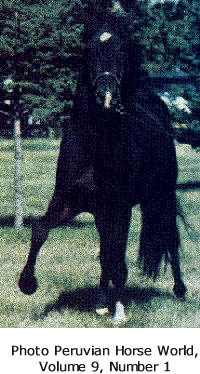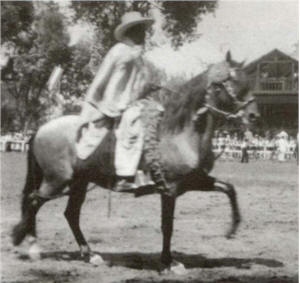|
|
|||||||
 |
The man who does not love a
horse ~ Spanish Proverb ~ |
||||||
|
History of the Peruvian Paso The Peruvian people protected this breed from outside influence for many years and have only allowed the horses out of the country for about 100 years. When they started they had extremely strict rules of ownership and breeding practices. Today, if you import a breeding horse from Peru the Peruvians retain rights to bring that horse back into their breeding program. Because of its isolation for over 400 years, the Peruvian Paso horse has evolved as one of the purest breeds in the world and as a unique entity in the horse kingdom. The existence of this breed has been called “the greatest triumph of genetic selection ever achieved by a group of breeders.” Thanks to its unique, inborn, four beat lateral gait, the Peruvian Paso horse is undoubtedly the smoothest riding horse in the world. The trademark of this breed is a special, inherited, and completely natural four beat lateral gait called paso llano. The paso llano is a broken gait. It consists of a permanent harmonic, and rhythmic tapping in which the animal makes gentle and pleasant alternating movement . It is a quick advance in which the center of the horse's gravity stays almost immobile, producing a smooth ride.
Until the seventeenth century, the majority of the world's horses were naturally gaited. Nearly all traveling was done on horseback. Horses with natural gaits were considerably more comfortable to ride than trotters, which were called “bone-breakers”. Trotters were better suited for pulling carts and carriages for long distances, as well for horseracing. As these uses for horses eclipsed travel riding, the numbers of trotters grew. The Peruvian Paso remained on as one of the very few breeds that not only retained its natural gait, but was celebrated for it. The modern Peruvian horse descends from the horses introduced into Peru by the Spanish in the sixteenth-century. The Spanish Conquistadors brought with them both Hacks(amblers) and Chargers (trotters) of the same breed to the New World and as recorded in the Archives of the Indios, the Spanish horse, the classic Andalusian, was a breed consisting of Galician (Celtic) horses of the North, Sorraia, and Barb of Morocco. In Peru, the classic Andalusian horse became the foundation for the Peruvian horse which has kept most of the characteristics that made the Andalusian so valuable during the conquest of South America. It is interesting to note here that the Andalusian horse in Spain has since changed through the influence of other European breeds introduced by foreign Royal houses that ruled Spain for two centuries. The Peruvian Horse is a “Hot Blood,” a purebred Spanish horse that was selectively bred for the amble after reaching the shores of Peru. No outside blood has been introduced into the Peruvian breed, as there was no need to cross with other breeds to produce taller, heavier or faster horses, as was the case in other countries such as Mexico, Argentina or the United States. The Peruvian horse was mainly developed to satisfy the need for a smooth and comfortable ride when overseeing plantations and traveling from one settlement to another. Selective breeding coupled with such factors as climate and forage served to modify succeeding generations and create a new breed which possess characteristics different from those of any other horse in the world. Peruvian Paso horses come in all basic, solid colors as well as greys and roans. The average height of the Peruvian is between 14hh and 15.3hh and the weight is commonly between 900 and 1,100 lbs, about the same as Morgans and Arabians. A major principle with Peruvian breeders is that great Peruvian horses are born and not trained. Training is designated to bring out the animal's inherent ability but not modify it artificially. To help insure retention of completely natural action and gait, no horse is allowed in the show ring with shoes or with hooves longer than four inches. All Peruvian breeders basically use the same training methods and equipment so that no advantage is gained through artificial devices or aids.
We would like to point out that the majority of this article is courtesy of Eduard van Brunschot Vega. We wanted to share this information with you because when we tell people we raise Peruvian Paso's they often do not know anything about the breed. It is our experience (trainer, breeder and equiine appraiser) that many breeds were gaited but then the gait was bred out of them. Once, we had a request from a man who was breeding Appaloosa's to help him find some old foundation bred Appaloosa's that still had the gait. He was cross breeding the Appaloosa's with Peruvian Paso's to breed the gait back into them. When talking to Appaloosa breeders they often do not know that their horse originally was a gaited horse, that some very old breeders thought it was a defect in the breed and had their gaited horses destroyed. It always amazes us that we as people try to change what nature has given us so effectively and it is unfortunate that we too often make huge errors in doing so. This is why at Fayebrook Farms we are so dedicated to foundation bred horses. More Famous Peruvian Pasos More about the Peruvian Pasos
|
|||||||
|
|
|||||||
|
|
|||||||
 The
paso llano is executed with a distinctive action in the front legs,
called Termino, a graceful, flowing movement in which the forelegs
are rolled towards the outside as the horse strides forward, much
like the arm motion of a swimmer. Termino is a spectacular and
beautiful natural action. It is not a wing or paddle and originates
in the shoulder giving the horse the ability to swing the leg
forward with minimum vertical force back. Both the gait and the
flashy leg action are naturally passed on to the offspring.
The
paso llano is executed with a distinctive action in the front legs,
called Termino, a graceful, flowing movement in which the forelegs
are rolled towards the outside as the horse strides forward, much
like the arm motion of a swimmer. Termino is a spectacular and
beautiful natural action. It is not a wing or paddle and originates
in the shoulder giving the horse the ability to swing the leg
forward with minimum vertical force back. Both the gait and the
flashy leg action are naturally passed on to the offspring.
 Today's Peruvuan Paso horse is the result of 400 plus years of
highly selective breeding. The breed is said to combine qualities
which may be considered “contradictory.” He is very
high-spirited-though easy to handle while loose and relaxed in his
movements. He has sparkling, brilliant action in the forelegs-yet he
is extremely smooth and sure-footed. He has refined appearance-yet
he is powerful. This has been accomplished due to the intelligence,
love and devotion of innumerable breeders (many anonymous). Their
arduous and silent work has made the Peruvian Paso horse one of the
country's greatest treasures and a unifying source for its people.
Today's Peruvuan Paso horse is the result of 400 plus years of
highly selective breeding. The breed is said to combine qualities
which may be considered “contradictory.” He is very
high-spirited-though easy to handle while loose and relaxed in his
movements. He has sparkling, brilliant action in the forelegs-yet he
is extremely smooth and sure-footed. He has refined appearance-yet
he is powerful. This has been accomplished due to the intelligence,
love and devotion of innumerable breeders (many anonymous). Their
arduous and silent work has made the Peruvian Paso horse one of the
country's greatest treasures and a unifying source for its people.
